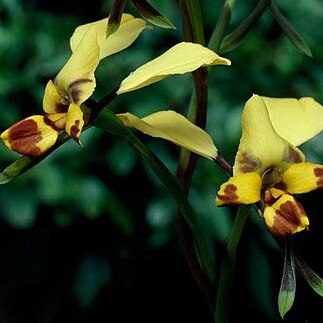Leaves 2, 250–350 × 3–4 mm, folded. Flower stem to 600 mm, 1–5-flowered. Flowers on erect slender pedicels, 20–25 mm across, chrome yellow with deep purplish brown markings or suffusions. Dorsal sepal erect, almost rhomboid, c. 10 × 4 mm, heavily blotched near base, margins speckled. Lateral sepals obliquely decurved beneath labellum, often crossed, linear-spathulate, c. 16 × 2.5 mm, brown and green. Petals obliquely erect, divergent, 12–13 mm long; stalk c. 7 mm long, dark; blade elliptic, c. 10 × 8 mm, yellow densely spotted and blotched. Labellum c. 10 mm long, spotted and blotched; lateral lobes spreading, curved, c. 8 mm long, narrow; midlobe wedge-shaped with long basal neck, almost wholly purplish brown, apex bluntly rounded. Callus ridges 2, c. 5 mm long.
Leaves 2, 150–300 × 4–6 mm, folded. Flower stem 300–500 mm, 2–8-flowered. Flowers 20–30 mm across, yellow with dark markings on dorsal sepal and labellum. Dorsal sepal erect, 8–11 × 6–8 mm, base dark. Lateral sepals deflexed, 14–16 × 2–3 mm. Petals erect; stalk 4–6 mm long, reddish brown; blade elliptical to ovate, 9–12 × 6–8 mm. Labellum 9–12 mm long; lateral lobes 4–6 × 2–2.5 mm; midlobe, wedge-shaped, 7–9 × 7–9 mm, folded. Callus ridges 2, 4–5 mm long, thick.
An orchid.

